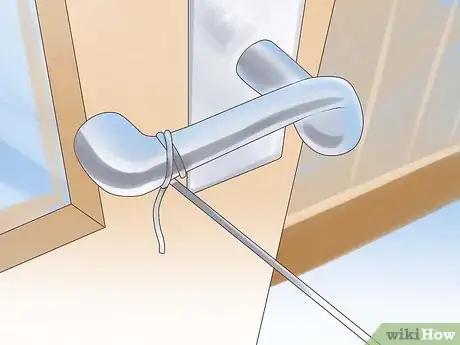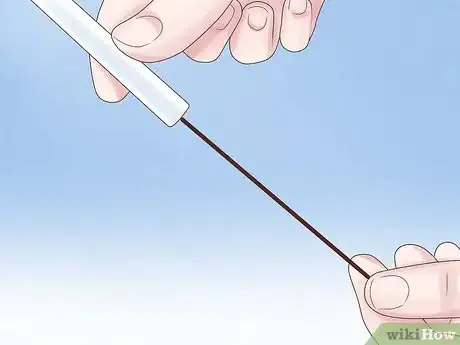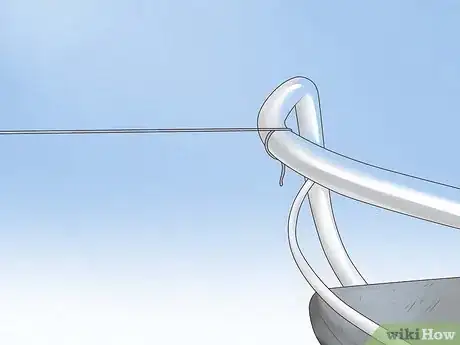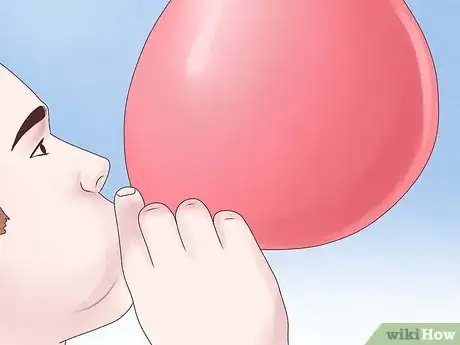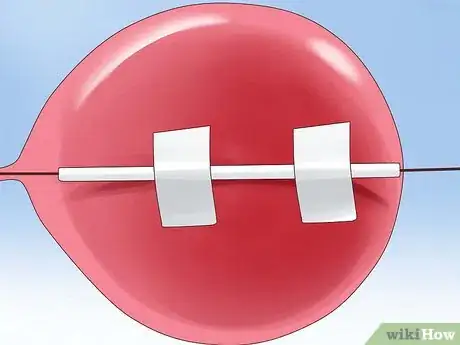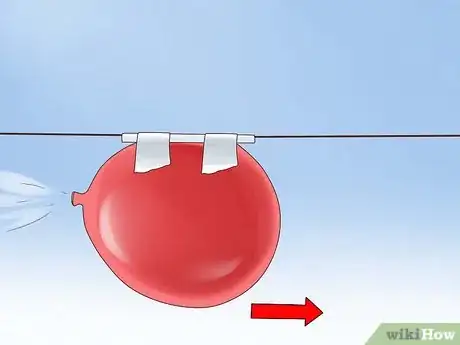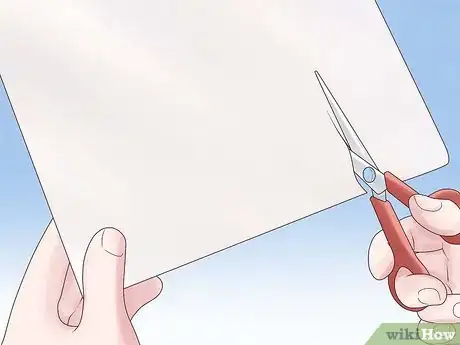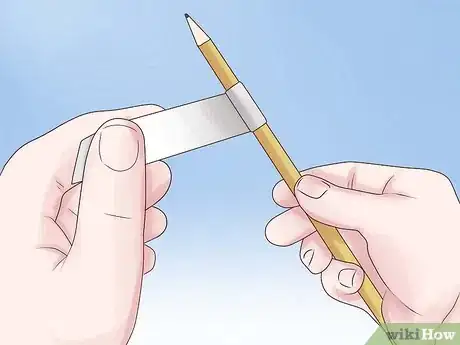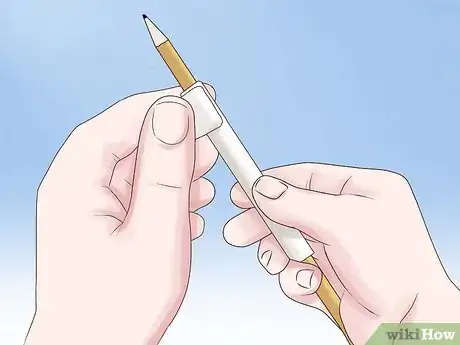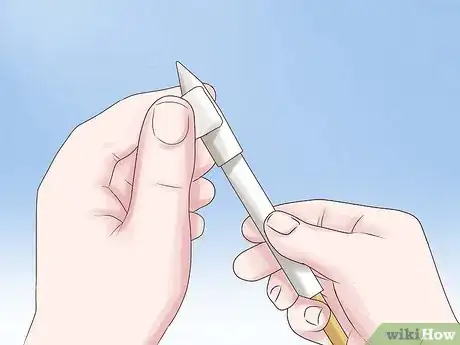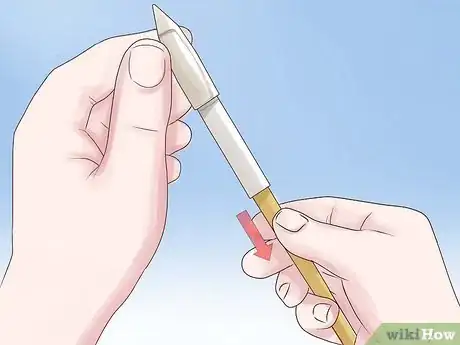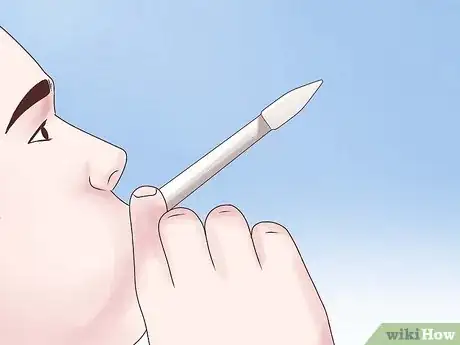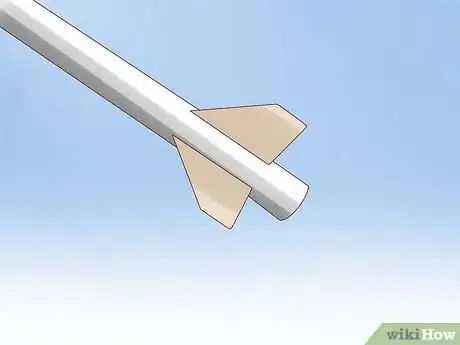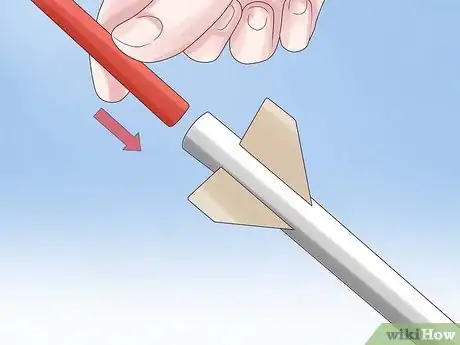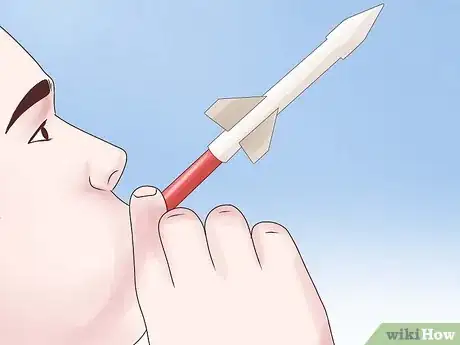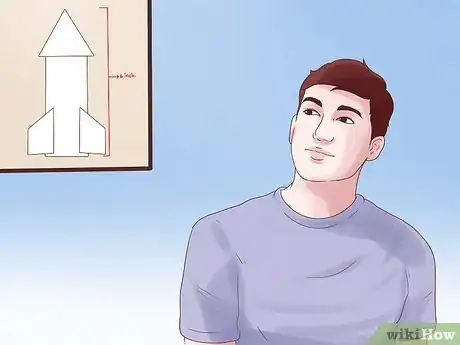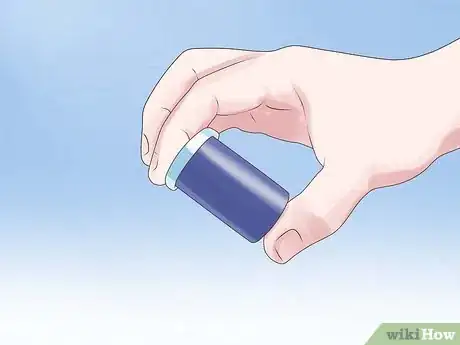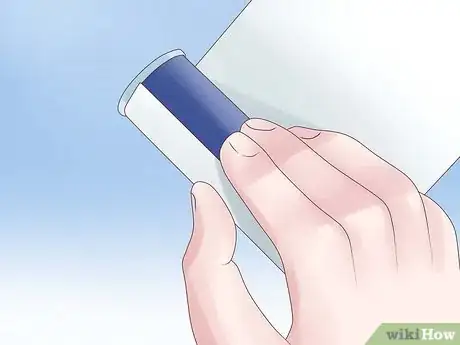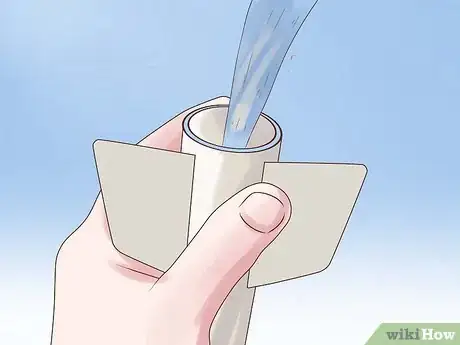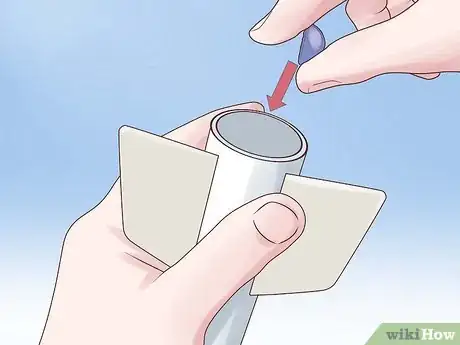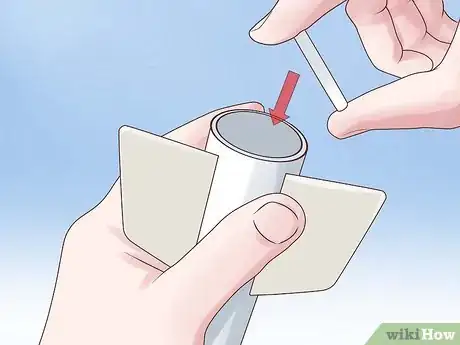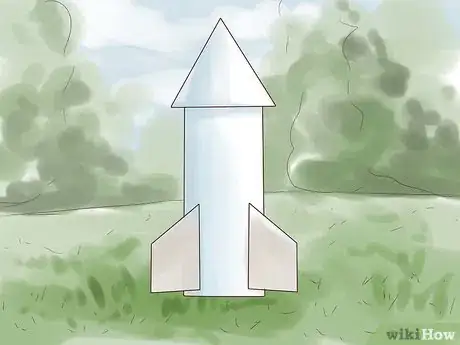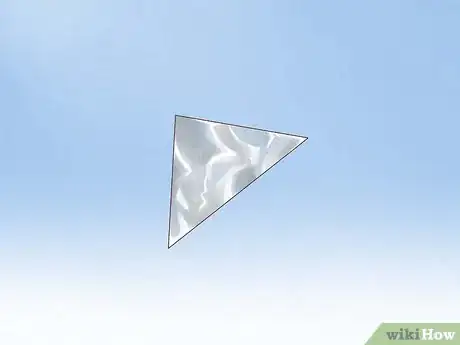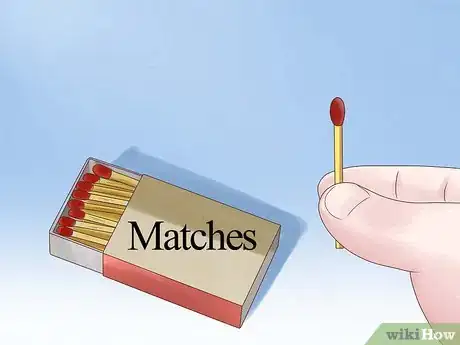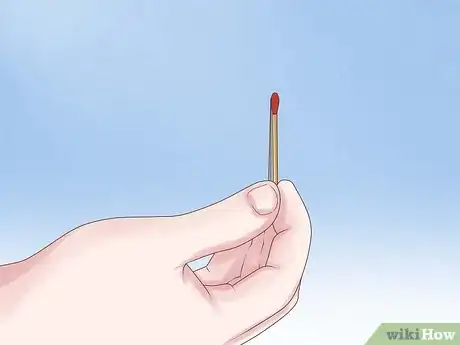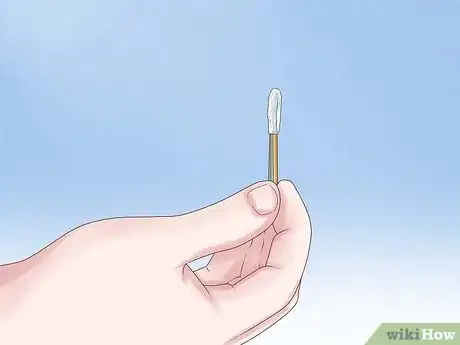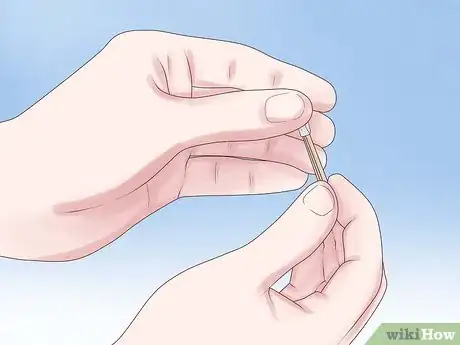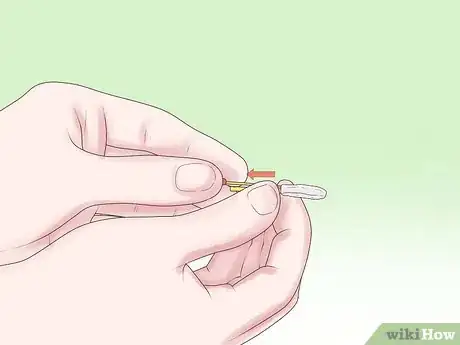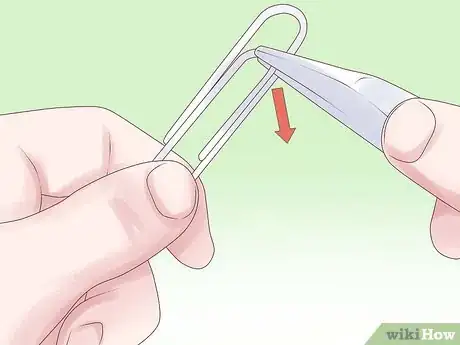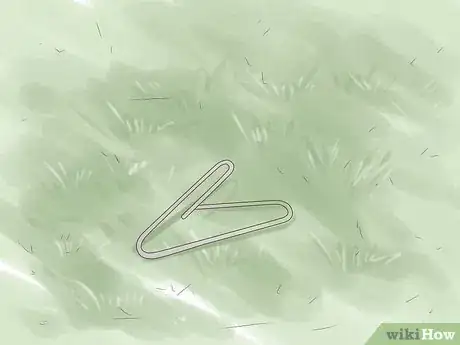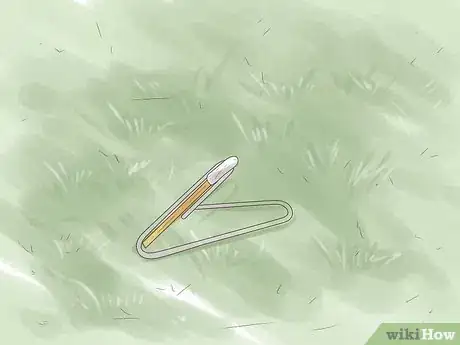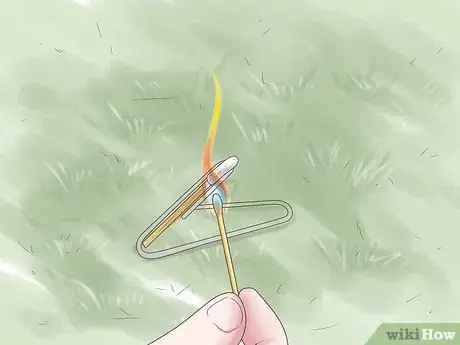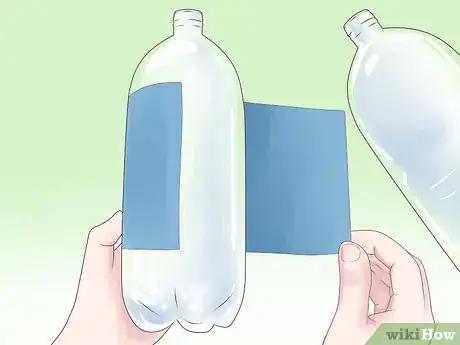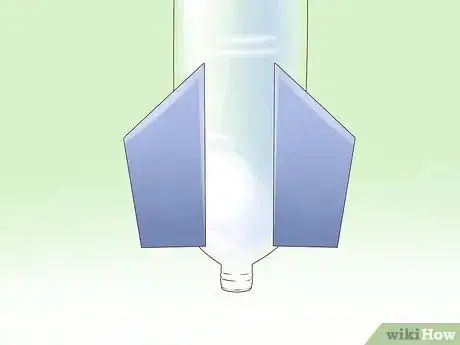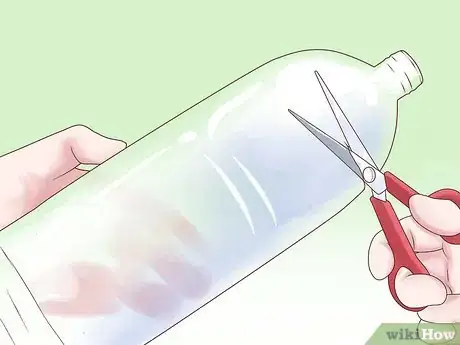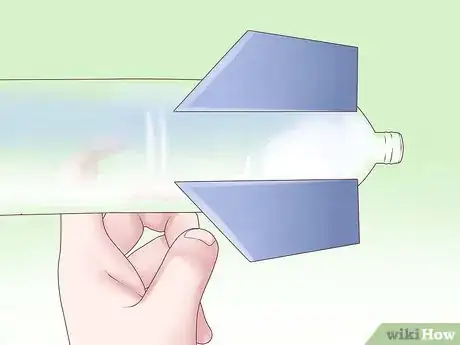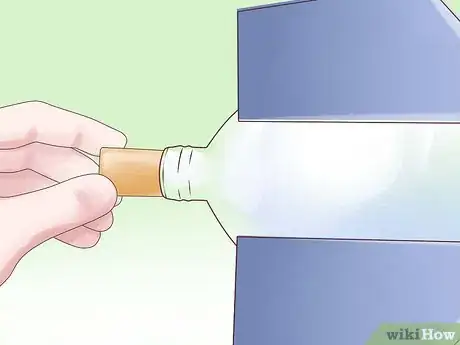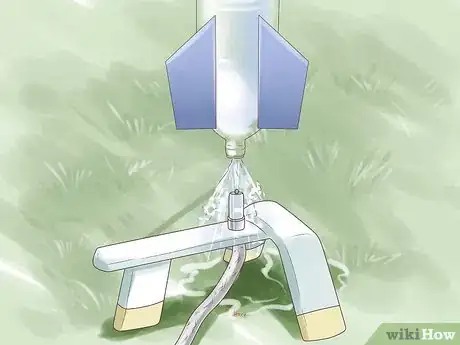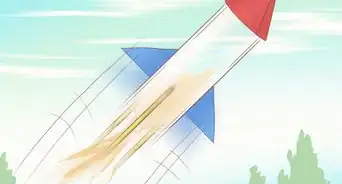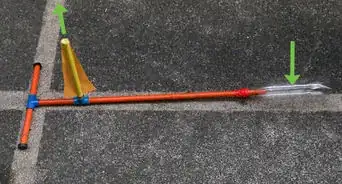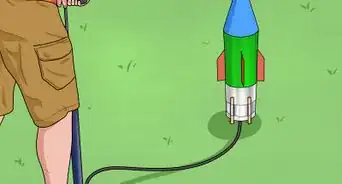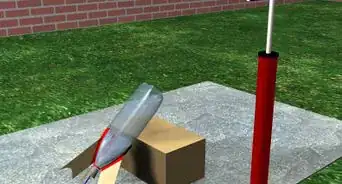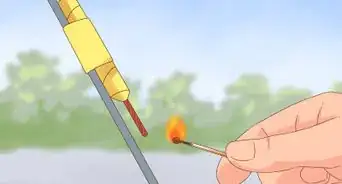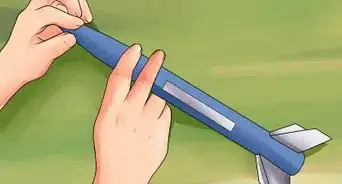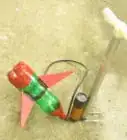This article was co-authored by Jessie Antonellis-John. Jessie Antonellis-John is a Math and Science Instructor who teaches at Southwestern Oregon Community College. With over 10 years of experience, she specializes in curriculum development. Jessie earned her PhD in Teaching & Teacher Education from the University of Arizona, her Master of Education from Western Governors University, and her BS in Astrophysics from Mount Holyoke College. She’s also co-authored several peer-reviewed journal articles in professional publications.
There are 12 references cited in this article, which can be found at the bottom of the page.
This article has been viewed 80,020 times.
Rockets illustrate Newton’s Third Law of Motion: “For every action, there is an equal and opposite reaction.” The first rocket may have been a steam-propelled wooden pigeon invented by Archytas of Tarentum in the fourth century B.C.[1] Steam gave way to the gunpowder tubes of the Chinese, then to the liquid-fueled rockets envisioned by Konstanin Tsiolkovsky and devised by Robert Goddard. This article describes five ways you can build your own rocket, from simple to more complex; at the end is an additional section that explains some of the principles guiding rocket construction.
Steps
The Balloon Rocket
-
1Tie one end of a length of string or fishing line to a support. Possible supports include a chair back or doorknob.
-
2Thread the line through a drinking straw. The string and straw will service as the guidance system to control the path of the balloon rocket.
- Model rocket kits often use a similar length of straw attached to the rocket body. This straw is threaded through a metal rod on the launching pad to keep the rocket upright before launch.
Advertisement -
3Tie the other end of the line to another support. Be sure to draw the line tight before tying it.
-
4Inflate the balloon. Pinch off the end of the balloon to keep the air from escaping. You can use your fingers, a paper clip, or clothespin.
-
5Tape the balloon to the drinking straw.
-
6Release the air from the balloon. Your rocket will travel along the guideline from one end to the other.
- You can try to make the balloon rocket with a round balloon instead of a long one, as well as various straw lengths to see how well they guide the balloon rocket. You can also raise the angle at which the balloon rocket flies to see how it affects the distance the rocket travels.
- A related device you can make is a jet boat: Cut a milk carton in half lengthwise. Make a hole in the bottom end and thread the end of a balloon through it. Inflate the balloon, then put the boat into a partially filled tub of water and release the air.
The Drinking Straw-Launched Rocket
-
1Cut out a rectangular paper strip. The strip should be about three times as long as it is wide: suggested dimensions are 4.5 inches (11.43 cm) by 1.5 inches (3.81 cm).[2]
-
2Wind the strip tightly around a pencil or dowel. Wind the strip near the end or point instead of at the center. Part of the strip should hang over the pencil point or dowel end.
- Be sure to use a pencil or dowel slightly thicker than a drinking straw, but not much thicker.
-
3Tape the edge of the strip to prevent unwinding. Tape lengthwise along the entire length of the strip.
-
4Fold the overhanging end into a point or cone. Tape up the nose cone so it holds its shape.
-
5Remove the pencil or dowel.
-
6Test for air leaks. Blow gently into the open end of the paper rocket. Listen for a rustle of air escaping along the side or nose cone and feel along the side seam and nose for a gentle stream of air. Tape over any leaks and test again until you can no longer detect any leakage.
-
7Add tail fins to the open end of the paper rocket. Because the paper rocket is narrow, you may want to cut attached pairs of fins that will be easier to tape onto the rocket’s end than three or four separate fins.
-
8Insert a drinking straw into the open end of the rocket. Be sure the straw extends far enough out of the rocket that you can grip it with your fingers.
-
9Exhale sharply into the straw. Your rocket will fly into the air, propelled by the force of your breath.
- Always point the straw and rocket upward, not toward anybody when launching.
- Vary how you build the rocket to see how the modifications affect its flight. Also, vary how sharply you exhale into the straw to see how it affects the distance your rocket flies.
- A toy similar to the paper rocket consisted of a stick with a plastic cone attached to one end and a plastic parachute attached to the other. The parachute was folded over the stick, which was then inserted into a cardboard blow-tube. When blown into, the plastic cone would catch the air and launch the stick. When it reached maximum height, the stick would fall, deploying the parachute.
The Film Canister Rocket
-
1Decide how long/tall you want to make your rocket. A good length/height is 6 inches (15 cm), but you can make the rocket longer or shorter if you wish.
- A good diameter is 1.5 inches (3.75 cm)[3] , but the actual diameter will be determined by the diameter of the rocket’s combustion chamber.
-
2Obtain a film canister. The canister will serve as the combustion chamber for your rocket. You can obtain one from a photography studio that still uses film.
- Look for a film canister whose lid has a stopper-like projection that goes inside the mouth of the canister instead of being held in place by a lip on the outside of the canister mouth.
- If you can’t find a film canister, you can use an empty prescription medicine bottle with a snap-on lid. If you can’t find a bottle with a snap-on lid, you can whittle a cork stopper that will fit tightly into the bottle mouth.
-
3Assemble the rocket. The easiest way to make the rocket body is to wrap a strip of paper around the film canister as with the pencil or dowel when making the drinking straw-launched rocket. Because the canister will launch the rocket, you may wish to tape or glue the paper onto the canister before wrapping it around the container.[4]
- Be sure to have the mouth of the canister or pill bottle pointing out when you attach the rocket frame to it.[5] The mouth will serve as the rocket nozzle.
- Instead of folding the end of the rocket body away from the canister into a nose cone, you can make a separate nose cone by cutting a paper circle, cutting from the edge just to the center, and folding the cut circle into a cone. You can affix the cone with either tape or glue.
- Add fins. Because this rocket is thicker in diameter than the paper rocket you launch with a drinking straw, you may want to cut individual fins to attach. You may also want to have three fins instead of four.
-
4Decide where you want to launch the rocket from. An open, outdoor location is recommended, as the rocket can reach a considerable height when launched.
-
5Fill the canister 1/3 full of water. If your water source isn’t near your launching pad, you may have to carry the rocket upside down or carry the water separately and fill the canister at the launch site.
-
6Break an effervescent tablet in half and drop half the tablet into the water.
-
7Cap the canister and turn the rocket upright on the launching pad.
-
8Get back to a safe distance. As it dissolves, the tablet will release carbon dioxide. The pressure will build until it pops the lid off the canister, launching the rocket.
- Instead of using water, you can instead fill the canister about half full of vinegar. In place of the effervescent tablet, you can use 1 teaspoon (0.18 ounce or 5 g) of baking soda. Vinegar, an acid (acetic acid), reacts with baking soda, a base, to produce water and carbon dioxide. Vinegar and baking soda are more volatile than water and effervescent tablets, however, so you need to get out of the rocket’s way a lot faster – and using too much of either chemical may rupture the canister.[6]
The Matchstick Rocket
-
1Cut a small triangle of aluminum foil. The triangle should be an isosceles triangle approximately 1 inch (2.5 cm) at the base and 2 inches (5 cm) from the center of the base to the apex.[7]
-
2Take a match from a book of matches.
-
3Line the match up against a straight pin. Place the match and pin so that the pinpoint touches the match head no higher than the thickest part of the head.
-
4Wrap the foil triangle, apex first, around the match head. Wrap the foil as tightly around the match head as you can without disturbing the pin. When you’re finished, the wrapping should extend about 1/4 inch (6.25 mm) below the match head.
-
5Crease the foil wrapping around the pin head with your thumbnails. This will push the wrapping closer to the match head and also better define the channel formed by the pin under the wrapping
-
6Slide the pin carefully out from the wrapping. Be careful not to tear the foil when you do this.
-
7Bend a paper clip into a launching pad.
- Bend the outer bend to a 60-degree angle. This will form the base of the launching pad.
- Bend the inner bend upward, then around to form an open-ended triangle. This is where you will rest the foil-wrapped match head.
-
8Place your launching pad at the launch site. Again, an open, outdoor location is strongly recommended, as the matchstick rocket can travel a considerable distance. Avoid locations that are exceptionally dry, as the matchstick rocket could start a fire.
- Be sure the surrounding area is clear before launching the rocket.
-
9Place the matchstick rocket in the launching pad, tip up. The rocket should rest at least at a 60-degree angle. If it rests any lower, you may have to bend the paper clip until it does.
-
10Launch the rocket. Light a match and put its flame directly under the wrapped match head. When the phosphorus in the wrapped match head ignites, the matchstick rocket should lift off.
- Have a pail of water handy to dunk spent matchstick rockets in to ensure they are completely extinguished.
- If a matchstick rocket should land on you, stop moving, drop to the ground, and roll until any flames are extinguished.
The Water Rocket
-
1Prepare an empty 2-liter soda bottle to serve as the rocket pressure chamber. Because bottles are used to make this rocket, it is sometimes called a bottle rocket. It should not be confused with the firecracker known as a bottle rocket, which is so named because it is often shot from inside a bottle. That form of bottle rocket is illegal to launch in many areas; the water rocket is legal in most areas.
- Remove the bottle label by cutting where it isn’t glued to the bottle. Be careful not to scrape or poke the bottle surface when doing this, as a scratch or cut will weaken it.
- Reinforce the bottle by wrapping it with strapping tape. New bottles can withstand pressures of up to 100 pounds per square inch (689.48 kilopascals), but repeated launching will reduce the amount of pressure the bottle can handle without rupturing.[8] You can wrap several bands of tape around the center of the bottle or wrap the bottle around its center and halfway from there to either end. Each band should go around the bottle twice.
- Mark out the places where you want to attach fins to the body with a marking pen. If you plan to have four fins, draw lines 90 degrees apart. If you plan to have three fins, draw lines 120 degrees apart. You may want to wrap a strip of paper around the bottle and make your markings on it first, then transfer the markings to the bottle.
-
2Construct the fins. Because the plastic rocket body is relatively durable, even though you’ve had to reinforce it, you’ll need fins at least as durable. Stiff cardboard may work for a while, but a better material is plastic of the kind used in pocket folders or three-ring binders.
- First, you’ll need to design your fins and create a paper template to serve as a cutting guide. However you design your fins, they should be designed so that the actual fin will be folded over (doubled) for extra strength and will reach to at least the point where the bottle narrows.
- Cut out the template and use it as a guide to cut into the fin material.
- Fold the fins into shape and attach them to the rocket body with strapping tape.
- Depending on the design of your launcher, you may not want to have the fins extend below the mouth of the bottle/the rocket nozzle.
-
3Create the nose cone and payload section. You’ll need a second 2-liter bottle for this.
- Cut the bottom out of the bottle.
- Place a payload in the upper section of the cut bottle. This can be a piece of modeling clay or a wad of rubber bands. Place the bottom section of the cut bottle inside the upper section, with the bottom toward the mouth of the upper section. Tape it in place, then tape the modified bottle onto the bottom of the bottle serving as the pressure chamber.
- Your nose cone can be anything from a 2-liter bottle cap to a length of PVC pipe to a plastic cone. Once you decide on the nose cone and assemble it, it should be permanently attached to the upper section of the cut bottle.
-
4Test-balance the assembled rocket. Balance the rocket on your index finger. It should balance somewhere above the top of the pressure chamber (the bottom of the first bottle). If it doesn’t, take the payload section off and adjust the weight.
- After you’ve found the center of mass, weigh the rocket. It should weigh from 7 to 8.5 ounces (200 to 240 g).
-
5Make the launcher/stopper. There are several devices you can make to launch your water rocket. The simplest is a valve and stopper that fits in the mouth of the pressure chamber bottle.[9]
- Find a cork that fits snugly in the mouth of the bottle. You may have to shave the edge slightly.
- Get a valve system of the kind used in an automobile tire or bicycle inner tube. Measure its diameter.
- Drill a hole in the center of the cork with a bit of the same diameter as the valve.
- Clean the valve stem and put a piece of tape over its threaded portion and opening.
- Thread the valve through the hole in the cork, then seal it in place with a silicone or urethane sealant. Let the sealant dry completely before removing the tape.
- Test the valve to make sure air passes freely through it.
- Test the stopper by putting a small amount of water in the rocket pressure chamber, then put the stopper in place and stand the rocket upright. If you find any leaks, reseal the valve and test again. Once you have determined there are no leaks, test again to find the pressure at which air forces the stopper out of the bottle.
- For instructions to build a more sophisticated launching system, see http://www.sciencetoymaker.org/waterRocket/buildWaterRocketLauncher.htm.
-
6Choose a launch site for your rocket. As with the film canister and matchstick rockets, an open outdoor location is strongly recommended. Because the water rocket is larger than the other rockets, you’ll need a larger open area than when launching either of the other rockets, and it also has to be flatter and more level than for the other rockets.
- An elevated surface such as a picnic table is a good idea when small children are present. [10]
-
7Launch your rocket.
- Fill the pressure chamber 1/3 to 1/2-full of water.[11] (You may want to add some food coloring to the water to produce a more colorful “exhaust” when the rocket launches.) It is also possible to launch the rocket without putting any water into the pressure chamber, although the target pressure may be different than that when the chamber has water in it.
- Insert the launcher/stopper into the mouth of the pressure chamber.
- Connect the hose of a bicycle pump to the launcher valve.
- Stand the rocket upright.
- Pump air until you reach the pressure at which the plug should be forced out. There may be a slight delay before the plug is forced out and the rocket launches.
Community Q&A
-
QuestionIs it better to use the rocket with water or air?
 Community AnswerIf you're using a 2-liter bottle, filling it about halfway with water and then pressurizing with air will cause it to go the highest.
Community AnswerIf you're using a 2-liter bottle, filling it about halfway with water and then pressurizing with air will cause it to go the highest. -
QuestionWill a regular water bottle work?
 Community AnswerA regular bottle will work, but you have to adjust the size of the other parts.
Community AnswerA regular bottle will work, but you have to adjust the size of the other parts. -
QuestionIs there anything to replace the gas chamber?
 Community AnswerYes, you could use a air tank or a helium air tank, but both are quite expensive.
Community AnswerYes, you could use a air tank or a helium air tank, but both are quite expensive.
Rocket Parts and How They Work
1. Use the propellant to lift the rocket into and move it through the air. A rocket flies by directing a stream of exhaust downward through one or more nozzles to push it upward (lift) and move it forward (thrust) through the air. Rocket engines work by mixing the actual fuel with a source of oxygen (an oxidizer), which allows them to work in space as well as in Earth’s atmosphere.
- The earliest rockets were solid-fuel rockets. These type of rockets include firecrackers, Chinese war rockets, and the two thin booster rockets employed by the Space Shuttle. Most such rockets have a hole in the center for the fuel and oxidizer to meet and combust.[12] The rocket motors used in model rockets use solid-fuel propellants, along with a series of charges to deploy the rocket’s parachute when its fuel is spent.[13]
- Liquid-fuel rockets feature separate pressurized tanks of a liquid fuel such as gasoline or hydrazine and liquid oxygen. These liquids are pumped into a combustion chamber at the base of the rocket; the exhaust is vented out through a cone-shaped nozzle.[14] The main thrusters on the Space Shuttle were liquid-fuel rockets supported by the external fuel tank carried underneath the shuttle at launch. The Saturn V rockets on the Apollo mission were also liquid-fuel rockets.
- Many rocket-powered craft also use smaller rockets on their sides to help steer the craft while in space. These are called maneuvering thrusters. The service module attached to the Apollo command module had such thrusters; the Manned Maneuvering Unit backpacks used by Space Shuttle astronauts also used such thrusters.
2. Cut air resistance with the nose cone. Air has mass, and the denser it is (particularly near Earth’s surface), the more it holds back objects trying to move through it. Rockets must be streamlined (given elongated, elliptical shapes) to minimize the amount of friction they encounter as they travel through the air, and for this reason, they typically have a pointed nose cone.
- Rockets that carry payloads (astronauts, satellites, or explosive warheads) typically carry those loads in or near the nose cones of their rockets. The Apollo command module, for instance, was cone-shaped.
- The nose cone also carries any guidance system a rocket may be carrying to help direct the rocket to where it’s going without letting it tumble. Guidance systems may include onboard computers, sensors, radar, and radio to provide information and control the rocket’s flight path.[15] (Goddard’s rockets used a gyroscope control system.) .[16]
3. Balance the rocket around its center of mass. The overall weight of the rocket must be balanced around a certain point within the rocket to ensure it flies true without tumbling. The point can be called the balance point, the center of mass, or the center of gravity.
- The center of mass for each rocket varies. In general, the balance point will be somewhere above the top of the fuel or pressure chamber.
- While the payload helps raise the rocket’s center of mass above its pressure chamber, too heavy a payload will make the rocket top-heavy, making it difficult to keep upright before launch and guide during liftoff. For this reason, integrated circuits were incorporated into spacecraft computers to reduce their weight. (This led to the use of similar integrated circuits, or chips, in calculators, digital watches, personal computers, and more recently, computer tablets and smartphones.)
4. Stabilize the rocket’s flight with tail fins. Fins help ensure that a rocket’s flight is straight by providing air resistance against changes in direction. Some fins are designed to extend below the rocket nozzle to also keep the rocket standing upright before it is launched.
- In the 19th century, Englishman William Hale devised another means for using tail fins to stabilize a rocket’s flight. He devised exhaust ports next to vane-like fins that caused escaping gases to push against the fins and rotate the rocket to keep it from veering. This process is called spin stabilization.[17]
Warnings
- Always wear eye protection when launching any of the free-flying rockets (rockets other than the balloon rocket). For larger free-flying rockets, such as the water rocket, protective headgear is also recommended to protect you if the rocket should hit you.⧼thumbs_response⧽
- Adult supervision is strongly recommended when working with any of the rockets propelled by anything stronger than the breath of the person launching them.⧼thumbs_response⧽
- Do not shoot any of the free-flying rockets at anyone.⧼thumbs_response⧽
Things You’ll Need
- Safety glasses (for all free-flying rockets)
- Protective headgear (for larger free-flying rockets)
For the balloon rocket:
- Long balloon
- Length of kite string or fishing line (10 to 15 feet/3 to 5 m)
- Drinking straw
- Paper clip or clothespin (or other means to pinch off balloon temporarily)
- Tape
- Places to tie string ends to
For the drinking-straw rocket:[19]
- Drinking straw
- Sheet of construction paper
- Scissors
- Pencil
- Tape
For the film canister rocket:[20] [21] [22]
- Sheet of construction paper
- 35-mm film canister (available at photography shop) or pill bottle (with snap-on lid)
- Scissors
- Tape
- Water
- Effervescent tablet (such as Alka-Seltzer or Efferdent)
- Vinegar (in place of the water)
- Baking soda (in place of the effervescent tablet)
- Pencil
- Glue
- Paper towels
For the matchstick rocket:[23]
- Book of matches
- Aluminum foil
- Scissors
- Wire cutters (optional)
- Straight pin
- Paper clip
For the water rocket:[24]
- 2-liter soda bottle (2)
- Marking pen
- Plastic pocket folders or 3-ring binder
- Strapping tape
- Cork or plastic stopper
- Valve stem (from a car tire or bicycle inner tube)
- Drill with bit the diameter of the valve stem
- Sealant
- Tire pump/air compressor with pressure gauge
References
- ↑ http://www.grc.nasa.gov/WWW/k-12/TRC/Rockets/history_of_rockets.html
- ↑ http://www.planet-science.com/categories/experiments/technology/2011/11/make-a-straw-rocket.aspx
- ↑ http://www.popsci.com/diy/article/2013-01/build-and-launch-mini-rocket
- ↑ http://spaceplace.nasa.gov/pop-rocket/en/
- ↑ http://spaceplace.nasa.gov/pop-rocket/en/
- ↑ http://makezine.com/projects/vinegar-and-baking-soda-rocket/
- ↑ http://www.matchstickrockets.com/howto.html
- ↑ http://www.sciencetoymaker.org/waterRocket/buildWaterRocketLauncher.htm
- ↑ http://waterocket.explorer.free.fr/workshop.htm#bottle
- ↑ http://waterocket.explorer.free.fr/workshop.htm#bottle
- ↑ http://www.sciencetoymaker.org/waterRocket/buildWaterRocketLauncher.htm
- ↑ https://www.grc.nasa.gov/www/k-12/rocket/srockth.html
- ↑ http://en.wikipedia.org/wiki/Model_rocket
- ↑ https://www.grc.nasa.gov/www/k-12/rocket/srockth.html
- ↑ https://www.grc.nasa.gov/www/k-12/rocket/rockpart.html
- ↑ http://www.grc.nasa.gov/WWW/k-12/TRC/Rockets/history_of_rockets.html
- ↑ http://www.grc.nasa.gov/WWW/k-12/TRC/Rockets/history_of_rockets.html
- ↑ http://en.wikipedia.org/wiki/Model_rocket
- ↑ http://www.planet-science.com/categories/experiments/technology/2011/11/make-a-straw-rocket.aspx
- ↑ http://spaceplace.nasa.gov/pop-rocket/en/
- ↑ http://www.popsci.com/diy/article/2013-01/build-and-launch-mini-rocket
- ↑ http://makezine.com/projects/vinegar-and-baking-soda-rocket/
- ↑ http://www.matchstickrockets.com/howto.html
- ↑ http://waterocket.explorer.free.fr/workshop.htm#bottle
About This Article
To make a rocket out of a balloon, tie a string to a support, like a doorknob, chair, or table leg. Then, thread the string through a drinking straw and attach it to a second support across the room, making sure the string is taut. Inflate the balloon by blowing into it or using a pump, and use your fingers, a paper clip, or a clothespin pinch off the end of the balloon to keep the air in. Once the balloon is inflated, tape it to the straw and position it with the pinched end facing the end of the string. Release the air from the balloon and watch Newton’s Third Law in action. If you want to learn how to make a rocket out of a straw or film canister, keep reading the article!
